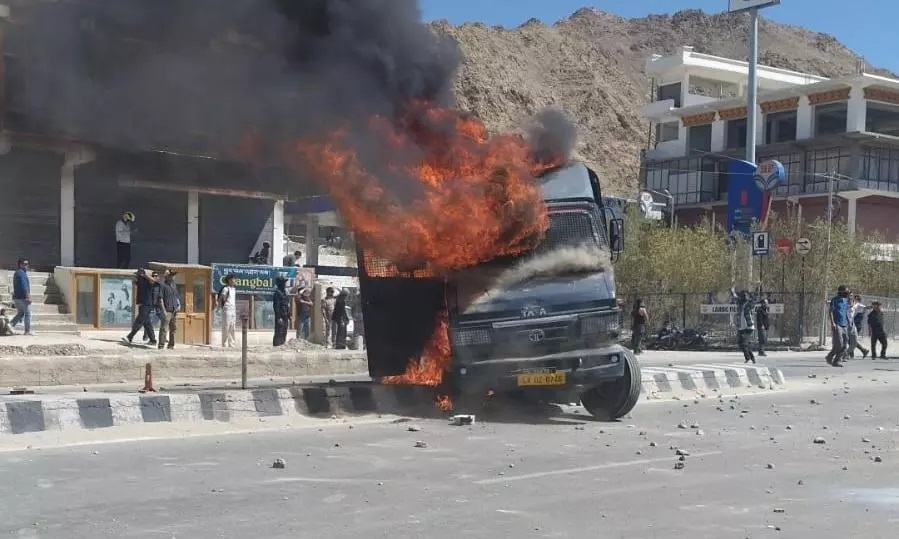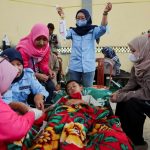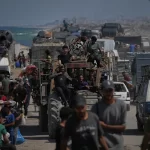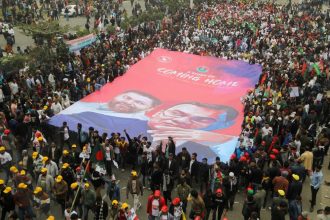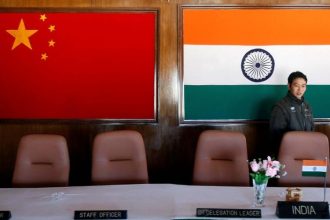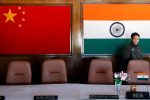Leh, Ladakh — The high-altitude desert of Ladakh, often portrayed in postcards and travel brochures as serene and timeless, erupted into chaos on Wednesday. Once the embodiment of Himalayan peace, Leh witnessed violent clashes between protestors and security forces, leading to the death of four people and injuries to at least 70 others. This marks the gravest unrest since Ladakh’s transition into a Union Territory (UT) in August 2019, following the revocation of Article 370.
At the heart of this crisis is Sonam Wangchuk — a visionary Ladakhi engineer, educationist, and Ramon Magsaysay Award winner. The Ministry of Home Affairs (MHA) has laid blame squarely on his shoulders, accusing him of provoking unrest by refusing to end his hunger strike and evoking images of the Arab Spring and Nepalese youth uprisings. According to the MHA, mobs “inspired” by his speeches targeted the BJP office, set fire to the Leh Hill Council Assembly hall, and even attempted to torch a CRPF vehicle with personnel still inside.
The Activist Speaks Out
But Wangchuk sees things differently. In a deeply emotional statement, he called the violence an “organic outburst” of despair, especially among the region’s youth. Ending his hunger strike prematurely, he said:
“This is the saddest day for Ladakh and for me personally… The peaceful path we followed for years has been betrayed.”
His accusations weren’t aimed at the youth, but at the political leadership — especially the BJP — for breaking their 2020 promises of statehood and constitutional protections. Ladakhi youth, he stressed, are not just angry — they are afraid. Afraid of losing their identity, their land, and their future.
Rooted in Fear, Not Hatred
Ladakhis are not merely reacting to political changes; they are defending a way of life. The Sixth Schedule of the Constitution — which grants special autonomous status to tribal regions — remains their central demand. It is seen as the only viable shield against exploitation, demographic dilution, and environmental degradation.
The unity of Leh Apex Body (LAB) and Kargil Democratic Alliance (KDA) — representing the Buddhist and Muslim populations — is historic. Together, they’ve led peaceful demonstrations for four years. Tuesday night’s mass shutdown of Leh was just another plea, a cry for attention before the pot boiled over into tragedy.
A Story of Promises Made… and Broken
The promise of UT status came with the hope of more autonomy. But with no legislature and no Sixth Schedule protections, that hope has morphed into helplessness. Negotiations with the Centre have repeatedly stalled, citing “lack of consensus” — while on the ground, consensus has never been stronger.
“People welcomed UT status in 2019. But now there’s only betrayal,” said political analyst Stanzin Dorje. “Lack of political voice, shrinking jobs, and environmental threats have made Ladakh a pressure cooker.”
Wangchuk: A Man Caught in the Middle
Wangchuk has never been a politician. He’s an innovator who built ice stupas to combat water shortages, reimagined rural education, and inspired a generation through sustainable development. But when promises faded and threats loomed, he stepped into the public square — not with fists, but with fasting.
His very presence symbolizes the soul of Ladakh — thoughtful, peaceful, yet determined.
Where Do We Go From Here?
As Ladakh remains under tight security with restricted internet and a heavy deployment of forces, the region stands at a crossroads. Lieutenant Governor Kavinder Gupta condemned the violence, but the people are asking for more than condemnation — they are asking to be heard.
In the dust of tear gas and burnt debris, a singular hope survives: Dialogue.
Wangchuk, despite personal grief and political attack, ended his message with a call for calm:
“Let’s keep our protests peaceful. Let’s not allow violence to destroy our cause.”
